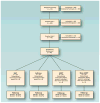A pilot study of a chiropractic intervention for management of chronic myofascial temporomandibular disorder
- PMID: 24080932
- PMCID: PMC4103021
- DOI: 10.14219/jada.archive.2013.0034
A pilot study of a chiropractic intervention for management of chronic myofascial temporomandibular disorder
Abstract
Background: Temporomandibular pain has multiple etiologies and a range of therapeutic options. In this pilot study, the authors assessed the feasibility of conducting a larger trial to evaluate chiropractic treatment of temporomandibular disorders (TMDs).
Methods: The authors assigned 80 participants randomly into one of the following four groups, all of which included a comprehensive self-care program: reversible interocclusal splint therapy (RIST), Activator Method Chiropractic Technique (AMCT) (Activator Methods International, Phoenix), sham AMCT and self-care only. They made assessments at baseline and at month 2 and month 6, including use of the Research Diagnostic Criteria for Temporomandibular Disorders.
Results: The authors screened 721 potential participants and enrolled 80 people; 52 participants completed the six-month assessment. The adjusted mean change in current pain over six months, as assessed on the 11-point numerical rating scale, was 2.0 (95 percent confidence interval, 1.1-3.0) for RIST, 1.7 (0.9-2.5) for self-care only, 1.5 (0.7-2.4) for AMCT and 1.6 (0.7-2.5) for sham AMCT. The authors also assessed bothersomeness and functionality.
Conclusions: The authors found the study design and methodology to be manageable. They gained substantial knowledge to aid in conducting a larger study. AMCT, RIST and self-care should be evaluated in a future comparative effectiveness study.
Practical implications: This pilot study was a necessary step to prepare for a larger study that will provide clinicians with information that should be helpful when discussing treatment options for patients with TMD.
Keywords: Oral Health Impact Profile; Temporomandibular disorder; chiropractic; chronic pain; randomized controlled trial.
Figures
Comment in
-
Questioning chiropractics.J Am Dent Assoc. 2014 Feb;145(2):127. doi: 10.1016/s0002-8177(14)60211-7. J Am Dent Assoc. 2014. PMID: 24487601 No abstract available.
-
More about chiropractics.J Am Dent Assoc. 2014 Feb;145(2):127. doi: 10.1016/s0002-8177(14)60212-9. J Am Dent Assoc. 2014. PMID: 24487602 No abstract available.
-
Response from the JADA Editor and the Associate Editor, Research.J Am Dent Assoc. 2014 Feb;145(2):127-8. doi: 10.1016/s0002-8177(14)60213-0. J Am Dent Assoc. 2014. PMID: 24487603 No abstract available.
References
-
- National Institute of Dental and Craniofacial Research. [Accessed Aug. 20, 2013];Facial pain. www.nidcr.nih.gov/DataStatistics/FindDataByTopic/FacialPain/
-
- DeBar LL, Vuckovic N, Schneider J, Ritenbaugh C. Use of complementary and alternative me dicine for temporomandibular disorders. J Orofac Pain. 2003;17(3):224–236. - PubMed
-
- La Touche R, Goddard G, De-la-Hoz JL, et al. Acupuncture in the treatment of pain in temporomandibular disorders: a systematic review and meta-analysis of randomized controlled trials. Clin J Pain. 2010;26(6):541–550. - PubMed
Publication types
MeSH terms
Grants and funding
LinkOut - more resources
Full Text Sources
Other Literature Sources
Medical


